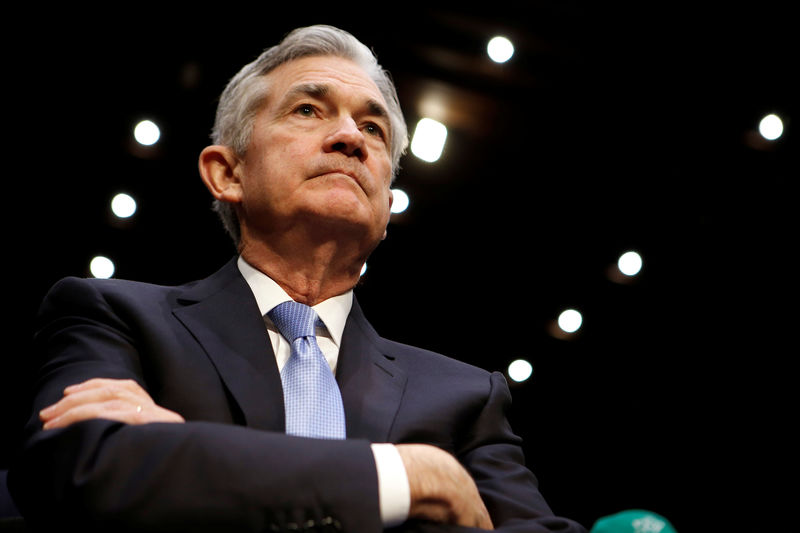(Bloomberg) -- Explore what’s moving the global economy in the new season of the Stephanomics podcast. Subscribe via Apple Podcast, Spotify (NYSE:SPOT) or Pocket Cast.
Federal Reserve Chairman Jerome Powell is likely to signal again this week that monetary policy is on hold, buttressing the belief that he may steer clear of action through 2020.
Surprisingly, that would be an historic anomaly for a U.S. presidential election year. Rather than keeping its head down, the Fed has changed policy in one direction or another in each of the last 10 presidential polling years -- though in 2016 it didn’t act to raise interest rates until after the November election.
In 2012 the Fed didn’t move its benchmark rate, which was already at zero, but did announce its third round of large-scale asset purchases in September.
“If you look back in history and see what the Fed did in election years, the Fed did everything they had to do,’’ said Roberto Perli, a partner at Cornerstone Macro in Washington. The best way for them to preserve their independence and credibility “is to do what they think is right.’’
That hasn’t always shielded them from criticism. President George H.W. Bush famously blamed then-Fed Chairman Alan Greenspan for costing him re-election in 1992 by failing to cut interest rates more aggressively. But it’s particularly vital now for the Fed to make the case that its policies are warranted by the economic outlook because of the relentless public assault on the institution by President Donald Trump.
Breaking with more than a quarter century of precedent, Trump has repeatedly lambasted the Fed and accused it of keeping credit too tight, most recently on Oct. 31, the day after it reduced rates for the third time this year.
Powell will have a chance to make his case twice this week, on Wednesday before the Joint Economic Committee of Congress and on Thursday to the House Budget Committee. He’s likely to echo the message he delivered after the latest Fed rate cut: The economy and monetary policy are in good place in the 11th year of America’s longest expansion.
Investors seem to agree. Stock and bond prices have risen in recent days on signs that the U.S. economy is weathering a slowdown abroad and on hopes of a phase-one deal in the U.S.-China trade war.
“Things feel a lot less threatening than they did two months ago,’’ said Carl Tannenbaum, chief economist with Northern Trust Corp (NASDAQ:NTRS). in Chicago. “The data for the U.S. has suggested that we’re not on the edge of falling off a cliff.”
Front and center in that regard was the October employment report, which showed payrolls rising by 128,000 despite the loss of 41,600 jobs due to the since-ended General Motors Co (NYSE:GM). strike.
Solid Payrolls
The solid jobs report allayed fears that companies spooked by the worldwide slowdown would chop payrolls just as they have done to capital outlays.
It also bolstered the Fed’s hopes that the consumer will continue to have the staying power to keep the expansion on track in the face of cutbacks by businesses.
Coupled with the policy message coming from Powell, the improved economic data prompted such Fed watchers as Michael Feroli of JPMorgan Chase (NYSE:JPM) & Co. and Matthew Luzzetti of Deutsche Bank (DE:DBKGn) Securities to rescind their forecasts of further rate cuts.
‘Material Reassessment’
Powell told reporters on Oct. 30 that it would take a “material reassessment’’ of the economic outlook for the Fed to change its current 1.5% to 1.75% interest rate target range.
In their September forecasts, policy makers saw the economy growing by 2% in 2020, inflation rising to near their 2% target and unemployment ending the year at 3.7%, according to their median projection. They’ll update predictions at their Dec. 10-11 meeting.
Speaking to Bloomberg Television on Nov. 1, Fed Vice Chairman Richard Clarida said if the central bank saw “accumulating evidence” that it was missing on its mandate for maximum employment or stable prices, or the growth needed to sustain both goals, “we would have to factor that in.”
Never Better
While saying that he still saw downside risks to the outlook, Clarida also highlighted the financial strength of U.S. households. “In the aggregate, the U.S. consumer’s never been in better shape,” he said.
Deutsche’s Luzzetti said it would take a real crack in the labor market and the consumer for the Fed to resume reducing rates. He expects policy to remain on hold next year even though he sees slowing growth pushing unemployment to 3.9%. It was 3.6% in October.
The bar to a rate hike seems even higher. Powell said that any decision to raise rates would be tied to the behavior of inflation, which remains stuck below the Fed’s 2% target.
“We would need to see a really significant move up in inflation that’s persistent before we would consider raising rates to address inflation concerns,’’ Powell said.
In describing the Fed’s current strategy, Powell has referred to the mid-cycle policy adjustment in 1995 and 1996, when Greenspan lowered rates three times after raising them previously.
The final cut back then came in January 1996, the start of a presidential election year. The central bank then kept rates unchanged for the rest of 1996.
“The Fed is probably on hold for a very long period of time,’’ Northern Trust’s Tannenbaum said.
